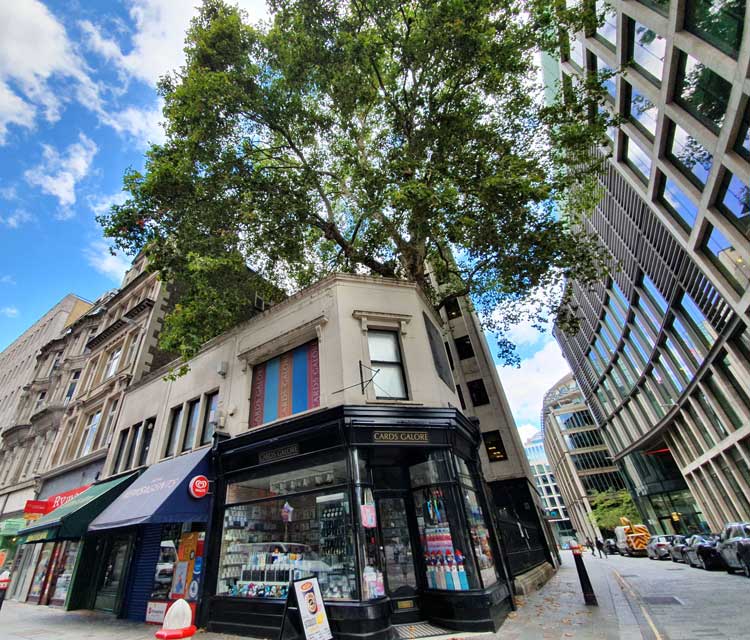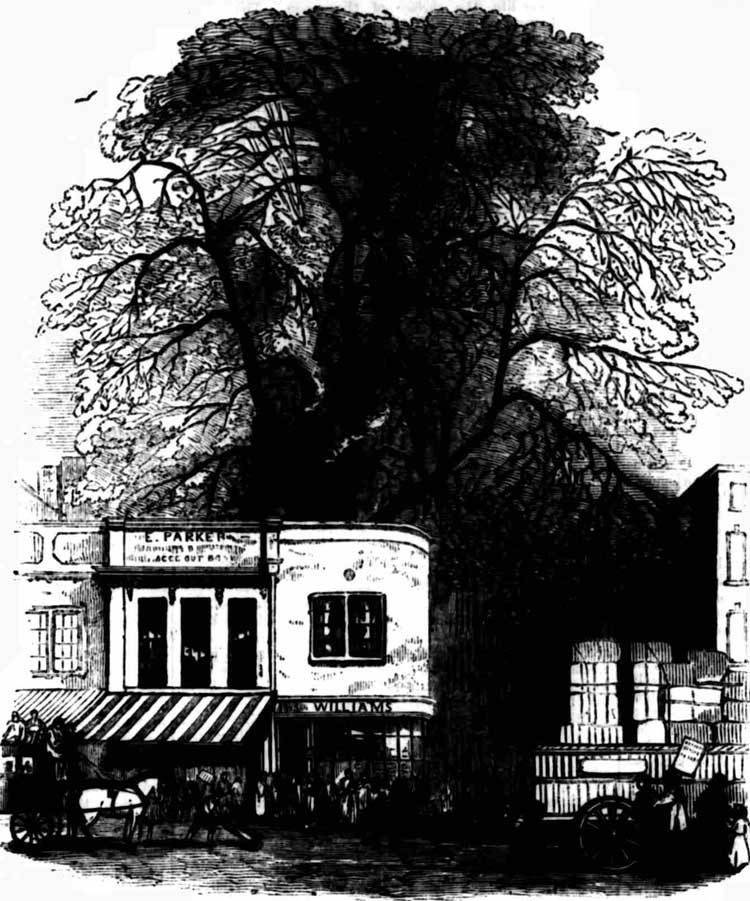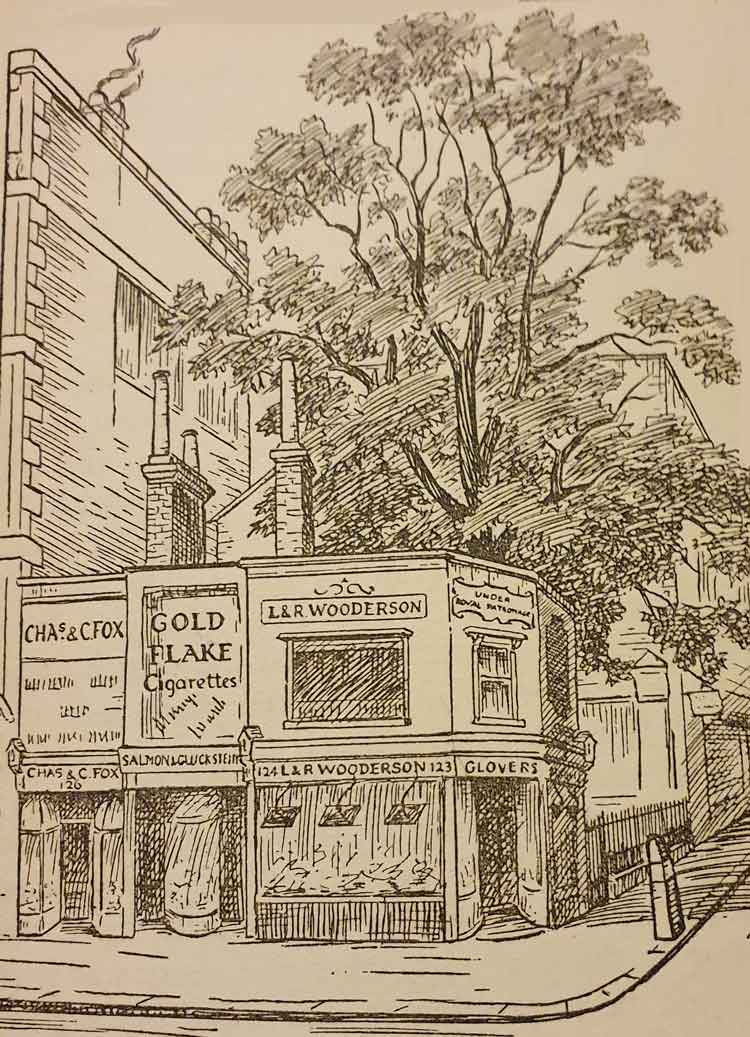
At the corner of Cheapside, when daylight appears, there stands an old Plane tree that's been here many years.
Quite how many years the venerable old plane has towered over the buildings at the junction of Cheapside and Wood Street is open to debate.
Some claim that the tree is the oldest tree in the City of London, others settle on its being one of the oldest trees in the City of London. According to the Friends of the City Gardens, who should know about this sort of thing, "the tree has been here a long time." Sounds pretty conclusive to me!
But, one thing is certain about this splendid example of London foliage, it is protected. In fact, it has listed status, and there is reputedly a clause in the lease of the two tiny buildings on the corner over which it spreads its leafy bough which forbids the construction of anything higher than one storey on the adjoining site in order to ensure the tree's survival.
A piece of evidence that is often used to establish a date by which the tree was towering over the little buildings at the corner of Wood Street, is the fact that William Wordsworth (1770 - 1850) mentions this very corner in his poem The Reverie Of Poor Susan, written in 1797.
At the corner of Wood Street, when daylight appears,
Hangs a Thrush that sings loud, it has sung for three years:
Poor Susan has passed by the spot, and has heard
In the silence of morning the song of the Bird.
'Tis a note of enchantment; what ails her?
She sees A mountain ascending, a vision of trees;
Bright volumes of vapour through Lothbury glide,
And a river flows on through the vale of Cheapside.
Green pastures she views in the midst of the dale,
Down which she so often has tripped with her pail;
And a single small cottage, a nest like a dove's,
The one only dwelling on earth that she loves.
She looks, and her heart is in heaven: but they fade,
The mist and the river, the hill and the shade:
The stream will not flow, and the hill will not rise,
And the colours have all passed away from her eyes!
However, before we get carried away with the fact that Wordsworth's mention of the corner in his poem is proof positive that the tree was around in 1797, it should be noted that he doesn't specifically mention the tree in his verse; but, rather, he gives us to understand that the thrush that sings at the corner of Wood Street "hangs" in a cage.
So, sadly, we cannot use Wordsworth, or his poetry, to establish a possible date for the tree.
However, by the mid-19th century, the tree was certainly being noticed, and was large enough to be considered a prominent local landmark, suggesting that it may well have been a sapling in the second half of the 18th century.
On Wednesday, 1st April, 1846, The Sun (not that one!), published the following article about the tree:-
"It is a singular fact that at the present time there are two crows nests in a lofty tree at the corner of Wood Street, Cheapside; the birds are mated.
One day last week a furious fight took place between the whole four of them, which ended in the partial demolition of one of the nests. The damage has been since repaired..."
By 1853, the Wood Street tree was evidently considered such a prominent local landmark that publisher and bookseller Samuel Roe was able to use it as an address locator in his advertisements.
Roe was the publisher and seller of what sounds like an absolute page-turner, "Rowe's 250,000 Cab Fares"; and, in order to promote his publication, he took out an advert in the Illustrated London News on Saturday, 13th August, 1853.
Evidently, Roe felt confident enough in the fact that his potential customers would be familiar with the tree to advertise his business address as being "Samuel Roe, under the Tree, Cheapside."

The Advert For Samuel Roe's business.
Copyright, The British Library Board.
Two years later, The Newport And Market Drayton Advertiser specifically mentions the tree in the following article, which appeared on Monday, 2nd July 1855, and, if the article is correct about the tree having been "a colony for rooks for more than a century", then that would date the tree to at least the mid 1750s.
The article read:-
"The Plane-tree at the corner of Wood-street, Cheapside, stands in the now unused churchyard of St. Peter.
It has been a colony for rooks for more than a century, for the fact is mentioned by Goldsmith, in his "Animated Nature," and by Coleridge and other of the great writers who have made London their homes.
Leigh Hunt says, that he was shown a child who never saw any other tree than the one in St. Paul's Churchyard - not even this in Cheapside - from which it may be fairly concluded that the child's parents had not taken it to the Temple Gardens, Lincoln's Inn Fields, or any other of the enclosed gardens within the City.
The truth is, that the tree in Cheapside strikes us as being singular because it stands so near the highway, and, as it were, in the midst of business; but there is no scarcity of trees and flowers even in the heart of what is now known as London..."
The article was accompanied by an illustration which shows the tree towering over the buildings beneath it, and its size would suggest that, even then, it was an old tree.

The Wood Street Tree in 1855.
Copyright, The British Library Board.
In a letter to The Gardener's Magazine, in September, 1881, a correspondent who signed himself "S. H." was fulsome in his praise of the Cheapside plane tree:-
"Although I have known this tree from a very early age, and remember well the rooks nests and their rooks, I have never bestowed upon it more than a casual glance until a few days since when I paused beneath its great green head and took particular note of its noble proportions.
I mention the matter now for the purpose of suggesting to lovers of trees that an observant look at this veteran may afford them considerable pleasure.
The stem is rugged, and shows that many a large side bough has been removed by the saw. But the head is perfect and spreads in the most liberal manner, brushing the windows on every side, so that some of them must be injuriously darkened.
That the tree is permitted to do this seems to me worthy of high praise, for to mutilate it would be truly shocking, its contour is so fine and its ample leafage so deliciously beautiful.
Its peculiar position and its fine rude health would present a paradox for our consideration, but I think the considerable bare space beneath explains the case sufficiently.
It has a body of soil for its support, and the winter rains no doubt suffice for its sustenance, but there is just no knowing where its searching roots may have tapped a gold mine, on which it can draw freely until some work of "improvement" shall cut through the roots or close the mine against them.
It seems to me that, of all the trees that have become venerable in London, the plane tree in Cheapside is the most venerable and, considering its circumstance, the most beautiful and most noble of them all."
The Manchester Courier and Lancashire General Advertiser, on Monday, 22nd July 1901 saw fit to praise the tree, quite literally, to the rooftops:-
"Is there a finer plane in any town in the kingdom than the one whose umbrageous foliage spreads itself half-way over Cheapside?
People gaze at it and wonder how on earth it is that so much costly space is given up to this tree.
It is protected by the terms of the leases under which the adjoining property is built, and it is consequence the most valuable tree in the world.
No shops, no warehouses must look down upon this "thing of beauty. It may grow as high as it likes, but the surrounding buildings must not keep pace with it.
This Cheapside tree is an autocrat. It brooks no interference on the part of authority or landlord, and it can claim as much room in the air as it wants. No one is jealous of such a growth, and when the trees in other thoroughfares achieve its maturity then will suburban London be a veritable leafy bower..."

The Wood Street Tree in 1901.
Copyright, The British Library Board.
However, by the end of that year, as reported in the following article, which appeared in The Illustrated London News on Saturday, 28th December, 1901, the tree was under threat:-
"The famous plane tree, which inspired Wordsworth to his ballad The Reverie Of Poor Susan has been endangered by a recent action of the London Consistory Court.
The tree grows on the site of an ancient burial ground, and the Court has just expunged from the deed surrendering the incumbent's right a condition that the land should not be built upon.
It is to be hoped, however, that the site will not be occupied until the tree has died a natural death.
As late as 1845, the rooks had a colony in the tree, and it is said that even later than that a survivor of the community held solitary state there. He, however, the legend runs, fell ingloriously to the seven-and-sixpenny air-gun of a sporting clerk in Wood Street."
Thankfully, the tree managed to survive this threat to its well-being, and was still considered prominent enough in 1910 for the then occupants of the building over which it towers, L & R Wooderson, Hosier, to advertise their address as "123 & 124 Cheapside (under the tree)".

The Wood Street Tree in 1928.
The tree managed to remain unscathed during the London Blitz that caused so much damage in the surrounding thoroughfares, and today it is a proud survivor, still standing tall over the churchyard and the tiny buildings that have been nestling beneath its leafy canopy for at least 180 years.
And long may it remain, or at least until the colours have all passed away from our eyes!